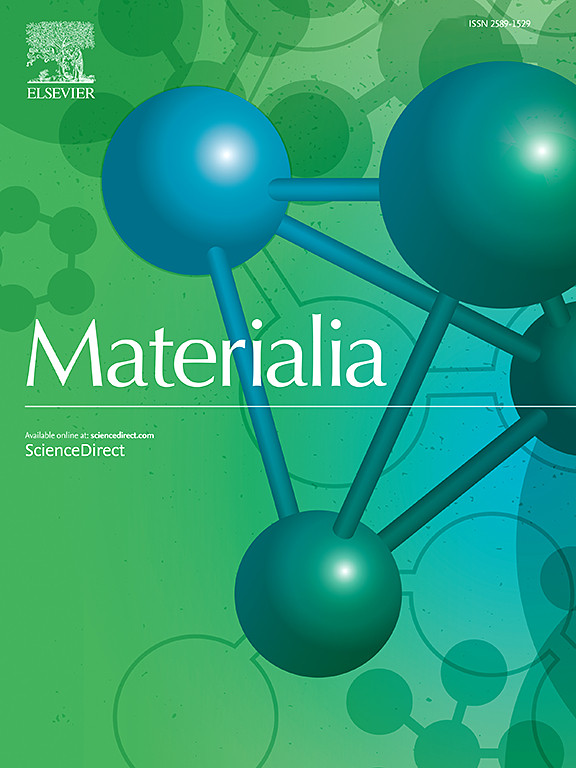Long term and in situ measurements of nanostructure evolution of Al-3.9Cu-1.5Mg alloys by laboratory high energy small-angle X-ray scattering
IF 3
Q2 MATERIALS SCIENCE, MULTIDISCIPLINARY
引用次数: 0
Abstract
The effect of nanostructures on the hardness of Al-3.9Cu-1.5Mg alloys with and without cold rolling (CR) during natural and isothermal aging at 190°C for up to 48 h has been investigated by in situ high energy laboratory small-angle X-ray scattering combined with micro-Vickers and calorimetry measurements. In the naturally aged samples, the formation of Cu-Mg co-clusters of 1 nm in diameter was observed. In the specimens with CR, the formation of clusters due to CR was observed at the beginning, while little change were observed during aging. Consequently, the total amount of clusters was less than in the specimens without CR in the later stage of natural aging. The change in the amount of age hardening corresponded to the change in the amount of Cu-Mg co-cluster formation, indicating that the Cu-Mg co-cluster was responsible for the precipitation strengthening at room temperature. At 190°C for the artificial aging process, precipitate scattering of three different sizes and shapes was observed, i.e., the intermediate and S phases were precipitated in addition to the Cu-Mg co-cluster. The continuous change in volume fraction and size with time suggests that the Cu-Mg co-cluster has grown into an intermediate phase. The time evolution of hardness at 190°C artificial aging without CR was simply explained by Orowan's equation. These results show that the dispersion state of precipitates mainly affects the hardness in Al-Cu-Mg alloys with low Cu/Mg ratios rather than the phases themselves.

实验室高能小角x射线散射对Al-3.9Cu-1.5Mg合金纳米结构演变的长期原位测量
采用原位高能实验室小角x射线散射、显微维氏和量热测量相结合的方法,研究了冷轧和不冷轧Al-3.9Cu-1.5Mg合金在190℃自然时效和等温时效48 h过程中,纳米结构对其硬度的影响。在自然时效的样品中,观察到直径为1 nm的Cu-Mg共簇的形成。在CR试样中,一开始观察到CR引起的团簇形成,而在时效过程中观察到的变化不大。因此,在自然老化后期,簇的总数少于未CR的标本。时效硬化量的变化与Cu-Mg共团簇形成量的变化相对应,表明Cu-Mg共团簇是室温下析出强化的主要原因。在190°C人工时效过程中,观察到三种不同尺寸和形状的析出相散射,即除了Cu-Mg共簇外,还析出了中间相和S相。体积分数和尺寸随时间的连续变化表明Cu-Mg共团簇已发育为中间相。用Orowan方程简单地解释了190℃无CR人工时效时硬度的时间演变。结果表明:影响低Cu/Mg比Al-Cu-Mg合金硬度的主要因素是析出相的弥散状态,而非相本身。
本文章由计算机程序翻译,如有差异,请以英文原文为准。
求助全文
约1分钟内获得全文
求助全文
来源期刊

Materialia
MATERIALS SCIENCE, MULTIDISCIPLINARY-
CiteScore
6.40
自引率
2.90%
发文量
345
审稿时长
36 days
期刊介绍:
Materialia is a multidisciplinary journal of materials science and engineering that publishes original peer-reviewed research articles. Articles in Materialia advance the understanding of the relationship between processing, structure, property, and function of materials.
Materialia publishes full-length research articles, review articles, and letters (short communications). In addition to receiving direct submissions, Materialia also accepts transfers from Acta Materialia, Inc. partner journals. Materialia offers authors the choice to publish on an open access model (with author fee), or on a subscription model (with no author fee).
 求助内容:
求助内容: 应助结果提醒方式:
应助结果提醒方式:


